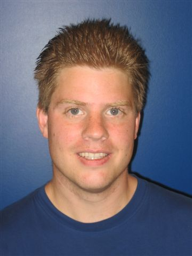Vibrational Phase Contrast CARS Microscopy
Promotion date: 2. July 2010
Promotors: Prof. Dr. Jennifer Herek
Assistant Promotor: Dr. Ir. Herman Offerhaus and Dr. Cees Otto
| This thesis describes coherent anti-Stokes Raman scattering (CARS) microscopy. This nonlinear optical technique utilizes specific bonds of molecules, referred to as the ‘fingerprint’ of a molecule, to obtain chemically specific imaging of a sample. It is a non-invasive method to identify structures of a specific chemical composition. However, CARS suffers from a frequency-independent background signal. The newly developed technique referred to as “Vibrational Phase Contrast CARS”, allows for rejection of the background, without reduction of the resonant signal. Furthermore, CARS microscopy is applied to biology, pharmacology and food, where it is combined with second harmonic generation microscopy and spontaneous Raman spectroscopy. Two in-depth studies are presented, on the dissolution behaviour of drugs and on early bone growth in cells. |
Can you mention some highlights, you experienced during your thesis project?
CARS is a promising laser microscopy technology. Without additions or disturbances, one can identify molecules present in tissues, cells or blood, leaving all bodily processes intact. This is done by identifying the molecules of interest by their internal vibrations. For example, this detection method opens application possibilities looking for proteins involved in Alzheimer disease. Also scanning methods are thinkable, to check if cancer surgery has been adequate.
One part of the research attracted attention on a national level even. We succeeded in filming live the difference in dissolution behaviour of smooth or rough-patterned tablets under organic circumstances. I performed as a guest at “De wereld draait door”, a high-profile talk show in the Netherlands. It is a special feeling to be recognized at the supermarket as a scientist. 1.5 million viewers watched this programme. So, I did my promotion bit of Mesa+, so to say.
Researchers can do more to seek publicity for their work, I believe. As a student, I contributed in campaigning activities for the university and for the faculty. I learned a great deal from that and, more important even, learned to like explaining my work to all kinds of audiences. Courses are available to learn how to deal with the media en develop presentation skills. This can be of use for researchers, I’m sure. Personally, I didn’t really need them. Gradually, I got into it in.
So, you consider it part of the job, as a scientist, to popularize your work.
If there are chances to do so, one must grab them immediately, in my opinion. A scientist should always be able to explain to non-experts what the research is about and what contribution it might make to society, be it in the far away future. To inform the public is a task, so everybody knows where public research money is going to.
At Mesa+, Dave Blank is very active in looking for media attention. Some research topics are suitable for this, for example the use of biochips in controlling diabetic blood values on a daily basis, as is performed by Medimate, a spin-off company of Mesa+.
Were you also able to get some scientific papers published?
Vibrational phase contrast CARS microscopy, was the more technical part of my project. We had some nice results, published in Physical Review Letters and several other highly ranked papers.
Did you feel part of the Mesa+ community during your thesis work?
First of all, I was part of the research group, working with a steady team, especially with Herman Offerhaus.
At Mesa+, multidisciplinary approach is common. In optics, for example, I was quite strong already. In biology however, I was coached a great deal by Cees Otto. Also the technicians in my group made deciding contributions in my project, especially Jeroen Korterik.
The experiment build-up was very complicated and expensive, worth about half a million euro. It is a great privilege being able to work with such equipment, having fun as a child and being paid on top of that.
I guess my work opens up possibilities to use the CARS technology for nanoscale experiments in the future.
What are your future plans?
After four years of academic research I am in for a new challenge now. In my future job, I hope to transform successes obtained in fundamental research, into products usable for clients, bringing in their demands.
Right now, I am looking for a job in industry. An academic career doesn’t suit me very well. The rules are very strict for gaining subsidy money and a fixed position is getting rare. I don’t like this kind of developments.

